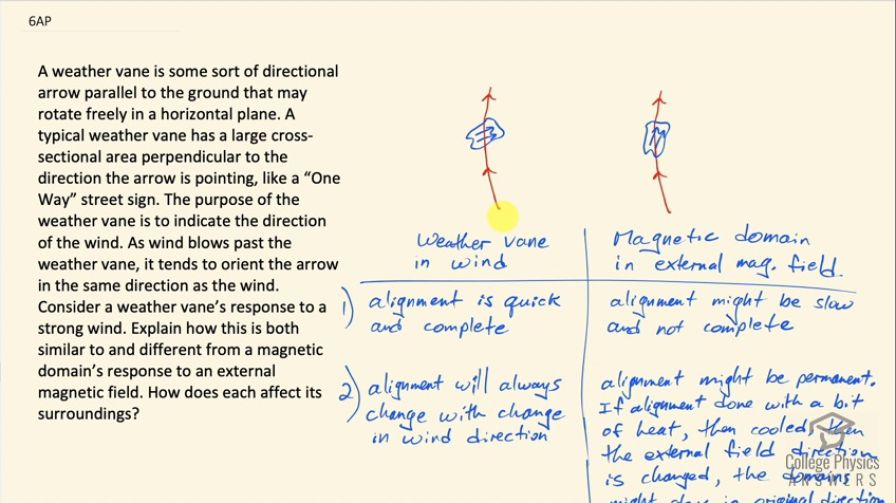Question
A weather vane is some sort of directional arrow parallel to the ground that may rotate freely in a horizontal plane. A typical weather vane has a large cross-sectional area perpendicular to the direction the arrow is pointing, like a “One Way” street sign. The purpose of the weather vane is to indicate the direction of the wind. As wind blows past the weather vane, it tends to orient the arrow in the same direction as the wind. Consider a weather vane’s response to a strong wind. Explain how this is both similar to and different from a magnetic domain’s response to an external magnetic field. How does each affect its surroundings?
Final Answer
Please see the solution video for a comparison.
Solution video
OpenStax College Physics for AP® Courses, Chapter 22, Problem 6 (Test Prep for AP® Courses)

vote with a rating of
votes with an average rating of
.
Video Transcript
This is College Physics Answers with Shaun Dychko. We are going to compare a magnetic domain that is in the presence of an external magnetic field that I have drawn in red and how it aligns with that field and compare that with how a weather vane aligns with wind. So a weather vane will align quickly with the wind and align completely whereas a magnetic domain it might take some time for this domain to be persuaded to align with the external magnetic field and when it does align, it might not be aligned completely... like I intentionally have this blue arrow a bit off to the right compared to the external field—that's in red here—kind of straight up. Another point of difference is that when the direction of the wind changes, the alignment of the weather vane will change with it this is the purpose of the weather vane is to always show the direction of the wind and continue showing its new direction when the wind changes direction. However depending on how the magnetic domain was treated when it aligned initially with this external field, the alignment might be permanent or which is not so much the alignment being permanent but the new direction of the domain might be permanent. So if this domain is heated a little bit while the external field is applied, and I say a little bit intentionally because if it's heated too much then it completely scrambles the domain and it points them all in different random directions if there's too much heat but if it's heated just a bit then it kind of loosens up the domain so that it is capable of aligning quite strongly or like you know, collinearly with this external field and if it's then cooled down so that it's not so moveable and then the external field is changed so that the external field is going in a different direction, it might be that this magnetic domain will not move to align with the new direction of the magnetic field so that's a difference compared to a weather vane, which always moves immediately with changes in direction of the wind. Okay! Number (3): the weather vane is not a source of wind— that's pretty obvious— so the weather vane doesn't cause other nearby weather vanes to align with the wind but magnetic domains are different because they are sources of magnetic field and when the domain aligns with the external field, it adds its own magnetic field to the external magnetic field creating a larger total magnetic field that will be experienced by nearby magnetic domains so this one will... this other magnetic domain above— this one that aligned— this one's now going to be compelled even more strongly to align with this external field because not only it's experiencing the external field but it's experiencing the field of this domain, which is pointing in the same direction and adding to the external field. So the alignment of domains further induces other domains to align.